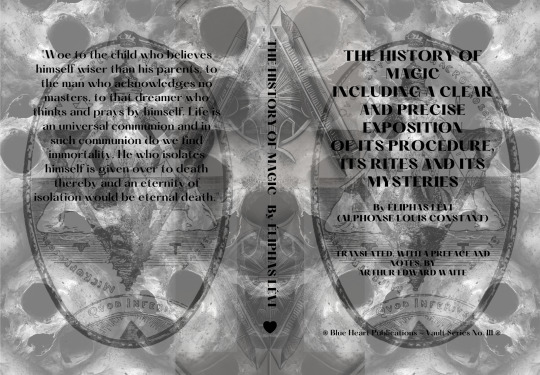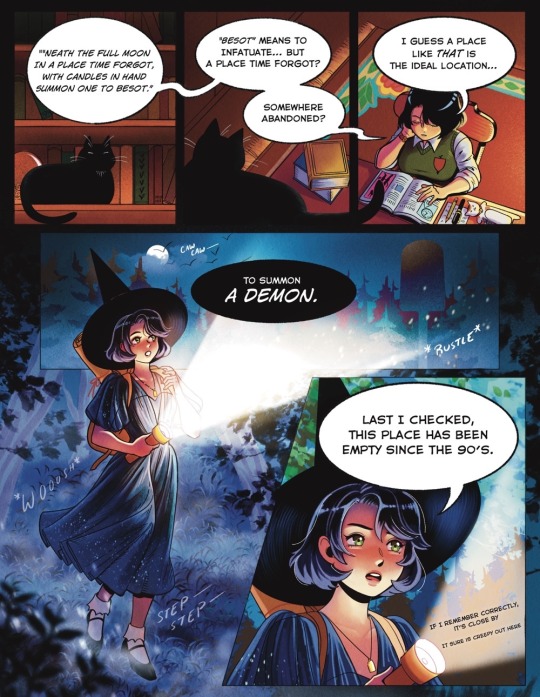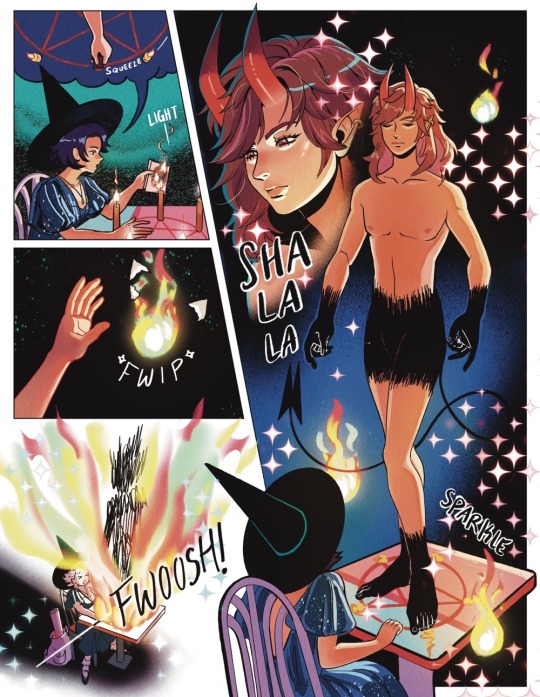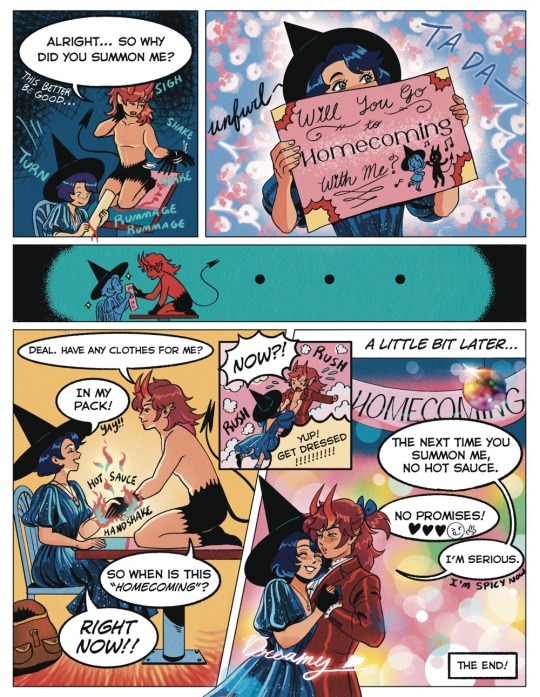#Rituals and Rites
Explore tagged Tumblr posts
Text

Happy Anthesteria!
Day 2, flowers!
Process (and flowers!) under the Cut


#Dionysus#Altars#Anthesteria#Hellenism#Hellenic Polytheism#Bacchus#Festivals and Holy days#Rituals and Rites#Flowers#So many flowers!!!#my posts#this photo does NOT do it justice!!!#AAAAAAA
101 notes
·
View notes
Text
"Unveiling the Arcane Tapestry: A Journey Through 'The History of Magic' by Éliphas Lévi"

Éliphas Lévi's "The History of Magic," skillfully translated by Arthur Edward Waite, stands as a profound exploration into the mystic realms of human knowledge. With a comprehensive blend of historical insight, ritualistic precision, and esoteric mysteries, Lévi takes readers on an enchanting odyssey through the labyrinthine corridors of magical practices.
Lévi's work delves into the historical roots of magic, unraveling its multifaceted procedures, rites, and enigmatic mysteries. Waite's translation ensures that the essence and nuances of Lévi's original French text are preserved, allowing readers to grasp the intricate details of magical traditions.
The narrative unfolds like a sacred scroll, unveiling the evolution of magical practices from ancient civilizations to the contemporary era. Lévi's keen observations and scholarly approach provide readers with a deep understanding of the philosophical and symbolic foundations that underpin magical arts.
Central to the book is the exploration of the human connection with the mystical forces that shape our reality. Lévi delves into the psychological and spiritual aspects of magic, emphasizing its transformative potential for individuals seeking a higher understanding of themselves and the universe.
Waite's translation enhances the accessibility of Lévi's complex ideas, making this work a valuable resource for both seasoned practitioners and those new to the realms of magic. The prose, though steeped in profound concepts, is presented in a manner that invites readers to contemplate and assimilate the wisdom imparted.
"The History of Magic" transcends the conventional boundaries of historical texts, emerging as a timeless guide for seekers of knowledge and wisdom. Lévi's vision, masterfully conveyed through Waite's translation, invites readers to embark on a journey of self-discovery and enlightenment, unlocking the secrets that lie within the intricate tapestry of magical history.
Éliphas Lévi's "The History of Magic," skillfully translated by Arthur Edward Waite is available in Amazon in paperback 18.99$ and hardcover 25.99$ editions.
Number of pages: 497
Language: English
Rating: 10/10
Link of the book!
Review By: King's Cat
#Éliphas Lévi#Arthur Edward Waite#History of Magic#Esoteric Knowledge#Mystical Traditions#Rituals and Rites#Magical Practices#Occult Wisdom#Spiritual Enlightenment#Symbolism in Magic#Transcendentalism#Hermeticism#Alchemy#Ancient Mysteries#Sacred Texts#Ritualistic Procedures#Symbolic Interpretation#Magical Philosophy#Mysticism Unveiled#Magical Evolution#Transformation of Consciousness#Ancient Civilizations#Secret Societies#Alchemical Mysteries#Spiritual Alchemy#Psychic Development#Esoteric Symbolism#Human Connection with Mystical Forces#Theosophy#Illumination
5 notes
·
View notes
Text
"Unveiling the Arcane Tapestry: A Journey Through 'The History of Magic' by Éliphas Lévi"

Éliphas Lévi's "The History of Magic," skillfully translated by Arthur Edward Waite, stands as a profound exploration into the mystic realms of human knowledge. With a comprehensive blend of historical insight, ritualistic precision, and esoteric mysteries, Lévi takes readers on an enchanting odyssey through the labyrinthine corridors of magical practices.
Lévi's work delves into the historical roots of magic, unraveling its multifaceted procedures, rites, and enigmatic mysteries. Waite's translation ensures that the essence and nuances of Lévi's original French text are preserved, allowing readers to grasp the intricate details of magical traditions.
The narrative unfolds like a sacred scroll, unveiling the evolution of magical practices from ancient civilizations to the contemporary era. Lévi's keen observations and scholarly approach provide readers with a deep understanding of the philosophical and symbolic foundations that underpin magical arts.
Central to the book is the exploration of the human connection with the mystical forces that shape our reality. Lévi delves into the psychological and spiritual aspects of magic, emphasizing its transformative potential for individuals seeking a higher understanding of themselves and the universe.
Waite's translation enhances the accessibility of Lévi's complex ideas, making this work a valuable resource for both seasoned practitioners and those new to the realms of magic. The prose, though steeped in profound concepts, is presented in a manner that invites readers to contemplate and assimilate the wisdom imparted.
"The History of Magic" transcends the conventional boundaries of historical texts, emerging as a timeless guide for seekers of knowledge and wisdom. Lévi's vision, masterfully conveyed through Waite's translation, invites readers to embark on a journey of self-discovery and enlightenment, unlocking the secrets that lie within the intricate tapestry of magical history.
Éliphas Lévi's "The History of Magic," skillfully translated by Arthur Edward Waite is available in Amazon in paperback 18.99$ and hardcover 25.99$ editions.
Number of pages: 497
Language: English
Rating: 10/10
Link of the book!
Review By: King's Cat
#Éliphas Lévi#Arthur Edward Waite#History of Magic#Esoteric Knowledge#Mystical Traditions#Rituals and Rites#Magical Practices#Occult Wisdom#Spiritual Enlightenment#Symbolism in Magic#Transcendentalism#Hermeticism#Alchemy#Ancient Mysteries#Sacred Texts#Ritualistic Procedures#Symbolic Interpretation#Magical Philosophy#Mysticism Unveiled#Magical Evolution#Transformation of Consciousness#Ancient Civilizations#Secret Societies#Alchemical Mysteries#Spiritual Alchemy#Psychic Development#Esoteric Symbolism#Human Connection with Mystical Forces#Theosophy#Illumination
0 notes
Text

Spectrum Rites
254 notes
·
View notes
Text










#blasphemy#satanism#satan#hail+satan#blasphamous#black metal#devil worship#unholy#antichrist#desecration#atheistic satanism#satanic bible#satanic rites#satanic metal#satanic sex#satanic worship#satanic ritual#satanic#satanic cult#satanic goat#ave satanas#i love satan#satanist#worship satan#hail satan#666 satan#satan is real#satanas#satanic nuns#satanic witch
183 notes
·
View notes
Text








“The Bell Tolls for Thee,” an original comic by me for Comix Accountability Club’s Anthology Vol. II: Rites, Rituals, and Ceremonies!
Please enjoy my silly homage to 90’s Taco Bell decor 💕
#comic#comics#comix#indie comics#indie comix#my art#illustration#mochiwei#original#original comic#digital art#procreate#demon oc#witch#taco bell#homecoming#rites#rituals#ceremonies#original art#original character#enjoyyyy#I really loved making this comic!!
243 notes
·
View notes
Text
Life-Sized Mortuary Doll from Siberia, c.250 CE: a small pouch filled with cremated human remains was tucked into the body of this mannequin, which was then stuffed with grass, dressed in furs, and buried

The mannequin measures about 1.5 meters (nearly 5 feet) tall, and it was crafted out of leather, fur, woollen fabric, tendon thread, silk, and grass. This is one of several mortuary dolls that have been found at the burial complex known as Oglakhty cemetery, which is located in the Oglakhty mountains of southern Siberia.

The mannequin's face was created from a patch of red woollen fabric; a rolled-up piece of leather was tucked beneath that patch in order to create the shape of the nose, while leather flaps were used to form the ears. Several black lines were also drawn across the face using charcoal.

The mannequin was positioned with its head resting atop a leather cushion filled with grass and reindeer fur.

Oglakhty cemetery is associated with the Tashtyk culture of southern Siberia. This article describes their unique burial practices, which often included a mix of mummification and cremation rituals:
The communities belonging to this group left numerous burial sites with an expressive funeral rite famous for its tradition of funeral masks and ‘dummies’: leather-made models of human bodies up to 1.5m in length, stuffed with grass, and containing charred human bones.
Of special interest is the fact that different rites were used to bury individuals in the same grave: the mummies and dummies both contained human bones. Remains of the mummies, i.e. dry bodies with trepanned skulls and faces covered with gypsum masks were lying side by side with the dummies.
And as this article notes:
These mannequins or so-called ‘dolls’ are the only surviving examples of burials of this type.
It's believed that the mannequins are dressed in clothing that was originally worn by the dead people they represent. Some of the mannequins also have plaits of human hair that were likely taken from the dead just prior to cremation; the hair was then used to form neatly-braided hairpieces that were typically placed upon the mannequins' heads.
Many of the graves at Oglakhty cemetery exhibit a peculiar mix of both inhumation and cremation. That blend of rituals is often attributed to the arrival of peoples/traditions from other regions, and the cultural diffusion that gradually occurred as a result:
Different ways of burying people in the same graves in the early Tashtyk cemeteries may reflect their different origins: descendants of local population and immigrants living and buried alongside each other.
Sources & More Info:
Antiquity: Pastoralists and Mobility in the Oglakhty Cemetery of Southern Siberia
Masters of the Steppe: Mummies and Mannequins from the Oglakhty Cemetery in Southern Siberia
Quarternary International: New Results of Radiocarbon Dating from the Oglakhty Cemetery
Research Square: First Ancient DNA Analysis of Mummies from the Post-Scythian Oglakhty Cemetery
Archeotravelers: The Face Hidden Behind the Mask
Great Sites of the Ancient World: Siberia's Oglakhty Mountains
#archaeology#artifacts#history#anthropology#oglakhty#mortuary dolls#mannequins#cremation#mummification#burial practices#siberia#russia#funerary rites#rituals#tashtyk#scythians#cultural diffusion#mummies and dummies
81 notes
·
View notes
Text
A good ritual for Ishtar Sinday.
Lord Satan be with you always. 🖤
#bible#burning#anti christianity#satan#hail satan#satanism#666 satan#satanic#theistic satanism#occult#hail thyself#satan is real#blasphemy#satanic rites#satanic ritual#devilman#actually demonic#fuck what they think#hot as hell
366 notes
·
View notes
Text

A wip of our dear Frater Imperator
I love and adore him, your honor
#my artwork#frater imperator#papa copia#cardinal copia#copia#cardi c#ghost rite here rite now#ghost ritual#the band ghost#ghost bc#rhrn spoilers
188 notes
·
View notes
Text

The Guardian of the Flame - This is a color corrected scan of the original portrait photo of Aleister Crowley in the Rites of Eleusis found in The JFC Fuller Papers at Rutgers University
#aleister crowley#occult#thelema#magick#occultism#ceremonial magick#Crowley#93#thelemite#Rites of Eleusis#mysticism#magic#ritual#ritual magick#occult history
81 notes
·
View notes
Text

I took one of those free online Harvard courses on The Rite of Spring (mistaking it for Waltz of the Flowers lmao) and honestly, I think I liked it way more than I expected, I binged the course in one day. Anyway, I decided to do a quick light study and decided Armand should be the chosen sacrifice from the ballet. I included a link to it, its a bit brutal and jarring but idk I like it both the music and the choreography. My favorite section is the Glorification of the Sacrifice & onward.
#the vampire chronicles#the vampire armand#armand#tvc#itwtv#the rite of spring#I think I should have expected to like it considering Im the type of person that has both KING and BIG GOD from Florence as my favorite MVs#i mean if you seen them i think you'd know why Im not too surprised I like it. there is just a level of brutality and punch I really like.#As for Armand I thought it was fitting for him to be in this considering the subject matter being an ancient ritual#and because I say so
132 notes
·
View notes
Text

Me strangling Tobias Forge for not putting Ritual, Con Clavi Con Dio, Mummy Dust, He Is and Year Zero on the official Rite Here Rite Now soundtrack
#redjys dumbposting#artists on tumblr#redjys artdump#digital art#sketch#oc#sona#tobias forge#ghost band#the band ghost#ghost bc#ghost#ritual#con clavi con dio#he is#mummy dust#year zero#rite here rite now#rhrn#rhrn movie#ghost rhrn
23 notes
·
View notes
Text





in honor of RHRN🧛🏼🦇
last one is so funny to me i had to 🏴☠️
papa, taken by me at the MKE ritual 💗
#the band ghost bc#rite here right now spoilers#rite here rite now#ritual#papa iv#papa emeritus fanart#papa copia#cardinal copia#copia#brother imperator#tobias forge#the band ghost#ghost ghouls#ghost#re imperatour#ghost sodo#nameless ghouls#fire ghoul#rain ghoul#sodo ghoul#cirrus ghoulette#cumulus ghost#per aspera ad astra#con clavi con dio#satan#rats#bats#ghost ritual#concert#plushia
54 notes
·
View notes
Text
So I know that "low effort" rituals are a big hit because like, we're all busy girlbossing or whatever, but in an effort to re-attune ourselves to, uh, ourselves, I think we should start bringing back longer, more encompassing rituals and rites.
I definitely experienced something through the new moon in scorpio, and like I do tarot readings so I am fully aware that most of you did too lol. The natural cycles of the world don't pause just because we stop paying attention. I spent this year mostly observing, but I'm pausing to reflect now and I'm outlining a rite that takes up an entire two weeks.
I know the backlash is going to be, "not everyone can put their life on hold for that long!"
Guys that's the point. You deserve to be able to put your life on hold that long. If an emergency happens and you can't avoid putting your entire life on hold, then what? Consider this rite a fire drill. And spanning an entire two weeks, you're not going to need to be 100% focused, meditating, fasting for the entire 15 days of the lunar event. But even if there is never an emergency. You deserve to be able to step back and breathe if you need to. Let your support system support you, and let the fires burn away anything that is no longer necessary. It will temper what is left.
It's meant to be paired with the new/dark moon in scorpio and advances until the full moon in taurus, but can be adjusted to fit literally whatever. I'm trying to keep it simple with enough instruction to make it accessible but its meant to be like a full energetic reset.
Do you guys like. Wanna read that? (60% of the instructions are "party hard and then take a really nice bath")
#he speaks#witchcraft#witch rite#ceremonial magic#new moon ritual#full moon ritual#energetic cleansing#cleansing ritual
25 notes
·
View notes
Text




#blasphemy#blasphamous#black metal#hail+satan#satan#satanism#devil worship#unholy#antichrist#desecration#satanic ritual#satanic rites#devil woman#worship satan
295 notes
·
View notes
Text

Sirius coded outfit
(Wore this for a ghost ritual but it was giving Sirius)
#marauders era#marauders#dead gay wizards#the marauders#seaksmoc#sirius black#sirius business#Sirius coded#Sirius vibes#sirius black is a fucking icon#sirius black coded#the band ghost#ghost#rite here rite now#ritual#ghost rite here rite now#ghost ritual
46 notes
·
View notes